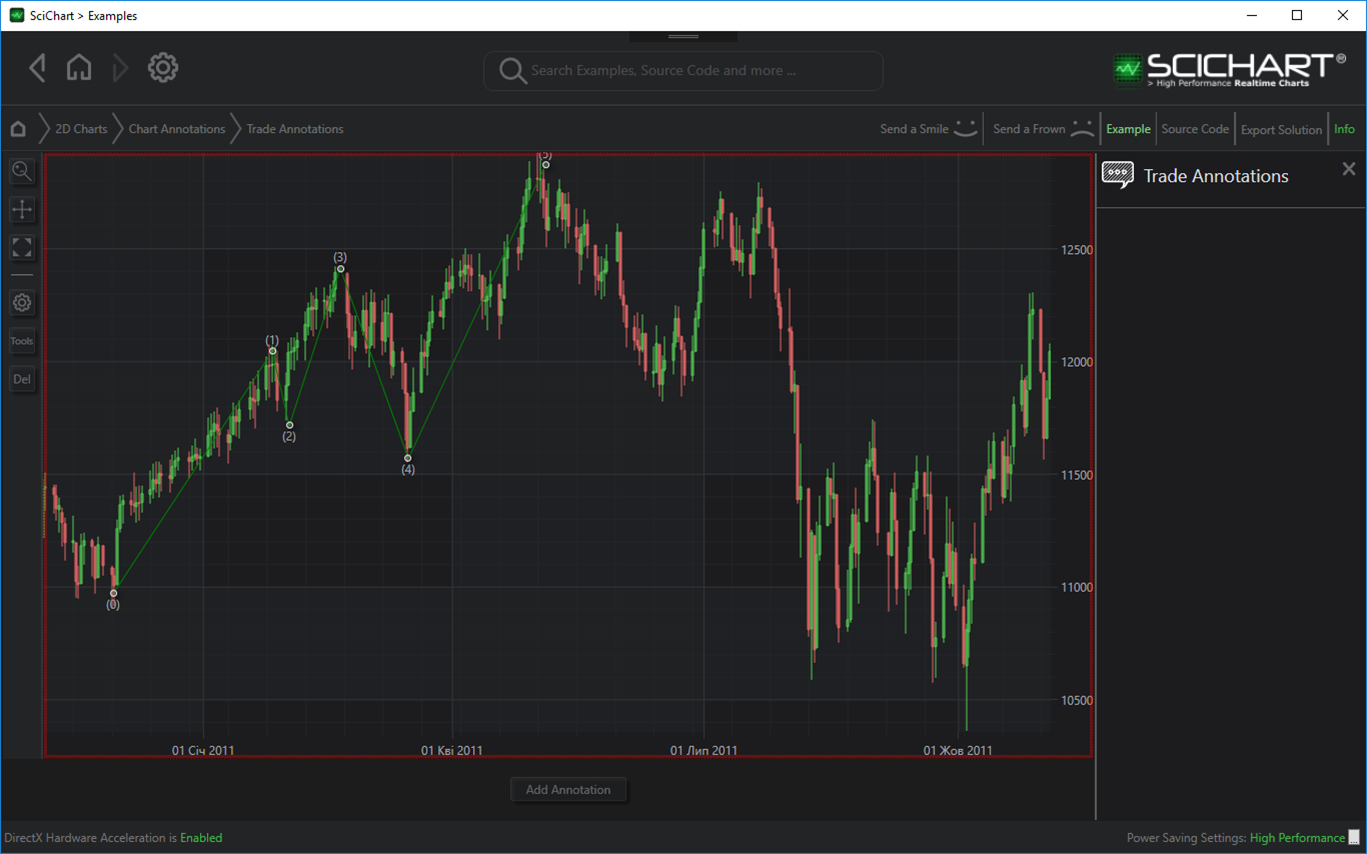The ElliotWaveAnnotation allows a user to draw a 1-2-3-4-5 wave structure on a price chart. To create this annotation you have to set points at your wave turning-points that will be connected by lines. Those points were limited by BasePointsCount (default value is 6).

The ElliotWaveAnnotation is derived from TradingAnnotationBase. This is a CompositeAnnotation, which shares the common properties of TradingAnnotationBase and consists of:
- Lines – which are actually LineAnnotations
- Text labels - which are TextAnnotations
Additional properties specific to ElliotWaveAnnotation include:
- TextStyle - defines the style for the text which is displayed at the turning points
Adding ElliotWaveAnnotations via mouse click
To add an ElliotWaveAnnotation via mouse click you have to add TradingAnnotationCreationModifier to your SciChartSurface.ChartModifier and set AnnotationType as ElliotWaveAnnotation. Please see the article on the TradingAnnotationCreationModifier for how to use this type.
Declaring an ElliotWaveAnnotation in XAML
To declare an ElliotWaveAnnotation in XAML you have to declare the annotation and then declare its InitialBasePoints collection that is actually collection of ComparablePoint objects. ComparablePoint stores X and Y values that are used for placing annotation point. InitialBasePoints collection is limited by BasePointsCount value. And default value is 6.
| Declaring an ElliotWaveAnnotation in XAML |
Copy Code |
|---|---|
<!-- XAxis, YAxis, RenderableSeries omitted for brevity --> <s:SciChartSurface.Annotations> <!--Declare ElliotWaveAnnotation--> <s:ElliotWaveAnnotation IsEditable="True"> <!-- Declare InitialBasePoints collection that is used for creating annotation from XAML. InitialBasePoints is actually observable collection of ComparablePoint-s. ComparablePoint stores X and Y point Value. --> <s:ElliotWaveAnnotation.InitialBasePoints> <!-- Placing first point --> <s:ComparablePoint X="0" Y="0"/> <!-- Placing second point --> <s:ComparablePoint X="2" Y="4"/> <!-- Placing third point --> <s:ComparablePoint X="4" Y="0"/> <!-- Placing fourth point --> <s:ComparablePoint X="6" Y="-4"/> <!-- Placing fifth point --> <s:ComparablePoint X="9" Y="0"/> <!-- Placing sixth point --> <s:ComparablePoint X="11" Y="-4"/> </s:ElliotWaveAnnotation.InitialBasePoints> </s:ElliotWaveAnnotation > </s:SciChartSurface.Annotations> | |
Please Note that the ElliotWaveAnnotation has limit of 6 base points. As you can see here, you just have to set this 6 points for FibonacciExtensionAnnotation: [X1=0; Y1=0], [X2=2; Y2=4], [X3=4; Y3=0], [X4=6; Y4=-4], [X5=9; Y5=0], [X6=11; Y6=-4] .
Declaring an ElliotWaveAnnotation in Code-Behind
To add an ElliotWaveAnnotation in code, simply use the following C# code:
| Declaring the ElliotWaveAnnotation in code |
Copy Code |
|---|---|
// Create a SciChartSurface. XAxis, YAxis omitted for brevity var sciChartSurface = new SciChartSurface(); // Create a ElliotWaveAnnotation. var elliotWave = new ElliotWaveAnnotation(); // ElliotWaveAnnotation should be added to //SciChartSurface.Annotation collection first, to make SetBasePoint() method //works correctly sciChart.Annotations.Add(elliotWave); // Set first point of ElliotWaveAnnotation elliotWave.SetBasePoint(0, 0); // Set second point of ElliotWaveAnnotation elliotWave.SetBasePoint(2, 4); // Set third point of ElliotWaveAnnotation elliotWave.SetBasePoint(4, 0); // Set fourth point of ElliotWaveAnnotation elliotWave.SetBasePoint(6, -4); // Set fifth point of ElliotWaveAnnotation elliotWave.SetBasePoint(9, 0); // Set sixth point of ElliotWaveAnnotation elliotWave.SetBasePoint(11, -4); | |
Declaring an ElliotWaveAnnotation in MVVM
To add an ElliotWaveAnnotation via MVVM please follow the instructions for adding annotations with MVVM: Declaring Annotations in MVVM with the AnnotationsBinding Markup Extension
To add a ElliotWaveAnnotation via a ViewModel you have to use SciChart markup extension called AnnotationsBinding,
| The AnnotationsBinding Markup Extension |
Copy Code |
|---|---|
<s:SciChartSurface Annotations="{s:AnnotationsBinding Annotations}"> </s:SciChartSurface> | |
Now you need to create collection for Annotations in ViewModel. Then create and add an ElliotWaveAnnotationViewModel to that collection of Annotations like this:
| Declaring the ElliotWaveAnnotation in a ViewModel |
Copy Code |
|---|---|
public class MyViewModel : INotifyPropertyChanged { public ObservableCollection<IAnnotationViewModel> Annotations { get; } public void Foo() { // Create a ElliotWaveAnnotation. elliotWave = new ElliotWaveAnnotationViewModel(); // ElliotWaveAnnotation should be added to //SciChartSurface.Annotation collection first, to make SetBasePoint() method //works correctly Annotations.Add(elliotWave); // Set first point of ElliotWaveAnnotation elliotWave.SetBasePoint(0, 0); // Set second point of ElliotWaveAnnotation elliotWave.SetBasePoint(2, 4); // Set third point of ElliotWaveAnnotation elliotWave.SetBasePoint(4, 0); // Set fourth point of ElliotWaveAnnotation elliotWave.SetBasePoint(6, -4); // Set fifth point of ElliotWaveAnnotation elliotWave.SetBasePoint(9, 0); // Set sixth point of ElliotWaveAnnotation elliotWave.SetBasePoint(11, -4); } } | |
